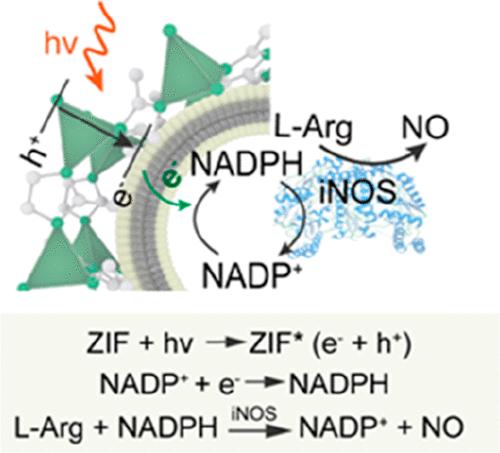Nanobiohybrid Extracellular Vesicle Nanoreactor with Improving Metabolical Activity for Biocatalytic Therapy
IF 16
1区 材料科学
Q1 CHEMISTRY, MULTIDISCIPLINARY
引用次数: 0
Abstract
Extracellular vesicles (EVs) hosting enzymatic activities that function as independent metabolic units are attractive natural biocatalytic platforms. However, directly using these metabolically active nanoreactors for effective biocatalytic applications remains challenging, mainly due to their constrained catalytic capabilities. Here, we construct an EV-templated nanobiohybrid system by engineering an EV surface with a photoresponsive zeolitic imidazolate framework (ZIF). The deposition of ZIF nanostructures on EVs not only contributes to improved biocatalytic stability but also enables interfacial coupling between photoexcited electrons from the ZIF and the enzymatic reaction of metabolically active EVs. Nearly 300% of biomass conversion efficiency increment could be achieved by EVs derived from macrophages. This enhanced biocatalysis, high catalytic stability, and low cytotoxicity endowed the EV@ZIF nanosystem with robust biosynthesis and antimicrobial activity. When evaluated in a mouse periodontitis model, we show that the autologous biocatalytic EV@ZIF demonstrated efficient therapeutic capability by killing bacteria and inhibiting inflammation. This nanoengineering strategy will benefit the future optimization of metabolically active EV nanoreactors as biocatalysts for a broad range of therapeutics.

用于生物催化治疗的具有改进代谢活性的细胞外囊泡纳米生物杂交反应器
细胞外囊泡(EVs)具有作为独立代谢单元的酶活性,是极具吸引力的天然生物催化平台。然而,直接利用这些具有代谢活性的纳米反应器进行有效的生物催化应用仍然具有挑战性,这主要是由于它们的催化能力受到限制。在这里,我们通过用具有光致伸缩性的唑基咪唑啉框架(ZIF)对电动汽车表面进行工程化处理,构建了一个电动汽车模板纳米生物杂交系统。在 EV 上沉积 ZIF 纳米结构不仅有助于提高生物催化稳定性,还能使 ZIF 的光激发电子与代谢活跃的 EV 的酶反应发生界面耦合。来自巨噬细胞的 EVs 可使生物质转化效率提高近 300%。这种增强的生物催化作用、高催化稳定性和低细胞毒性赋予了 EV@ZIF 纳米系统强大的生物合成和抗菌活性。在小鼠牙周炎模型中进行评估时,我们发现自体生物催化 EV@ZIF 通过杀死细菌和抑制炎症表现出高效的治疗能力。这种纳米工程策略将有助于优化具有代谢活性的 EV 纳米反应器,使其成为广泛治疗的生物催化剂。
本文章由计算机程序翻译,如有差异,请以英文原文为准。
求助全文
约1分钟内获得全文
求助全文
来源期刊

ACS Nano
工程技术-材料科学:综合
CiteScore
26.00
自引率
4.10%
发文量
1627
审稿时长
1.7 months
期刊介绍:
ACS Nano, published monthly, serves as an international forum for comprehensive articles on nanoscience and nanotechnology research at the intersections of chemistry, biology, materials science, physics, and engineering. The journal fosters communication among scientists in these communities, facilitating collaboration, new research opportunities, and advancements through discoveries. ACS Nano covers synthesis, assembly, characterization, theory, and simulation of nanostructures, nanobiotechnology, nanofabrication, methods and tools for nanoscience and nanotechnology, and self- and directed-assembly. Alongside original research articles, it offers thorough reviews, perspectives on cutting-edge research, and discussions envisioning the future of nanoscience and nanotechnology.
文献相关原料
公司名称
产品信息
阿拉丁
sodium alginate
阿拉丁
l-arginine hydrochloride
阿拉丁
2-methylimidazole (HmIm)
阿拉丁
Zinc nitrate
 求助内容:
求助内容: 应助结果提醒方式:
应助结果提醒方式:


